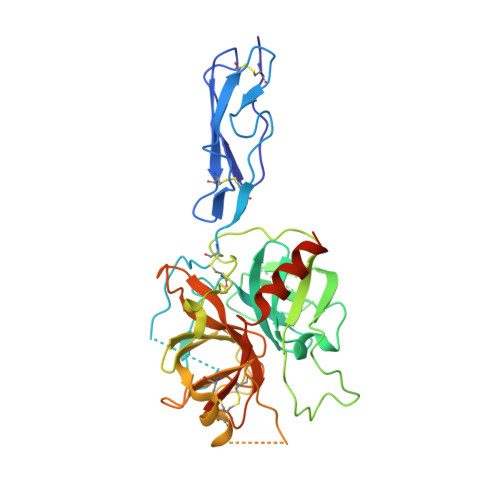Inhibition of the C1s Protease and the Classical Complement Pathway by 6-(4-Phenylpiperazin-1-yl)Pyridine-3-Carboximidamide and Chemical Analogs.
Xu, X., Herdendorf, T.J., Duan, H., Rohlik, D.L., Roy, S., Zhou, H., Alkhateeb, H., Khandelwal, S., Zhou, Q., Li, P., Arepally, G.M., Walker, J.K., Garcia, B.L., Geisbrecht, B.V.(2024) J Immunol 212: 689-701
- PubMed: 38149922
- DOI: https://doi.org/10.4049/jimmunol.2300630
- Primary Citation of Related Structures:
8TYP - PubMed Abstract:
The classical pathway (CP) is a potent mechanism for initiating complement activity and is a driver of pathology in many complement-mediated diseases. The CP is initiated via activation of complement component C1, which consists of the pattern recognition molecule C1q bound to a tetrameric assembly of proteases C1r and C1s. Enzymatically active C1s provides the catalytic basis for cleavage of the downstream CP components, C4 and C2, and is therefore an attractive target for therapeutic intervention in CP-driven diseases. Although an anti-C1s mAb has been Food and Drug Administration approved, identifying small-molecule C1s inhibitors remains a priority. In this study, we describe 6-(4-phenylpiperazin-1-yl)pyridine-3-carboximidamide (A1) as a selective, competitive inhibitor of C1s. A1 was identified through a virtual screen for small molecules that interact with the C1s substrate recognition site. Subsequent functional studies revealed that A1 dose-dependently inhibits CP activation by heparin-induced immune complexes, CP-driven lysis of Ab-sensitized sheep erythrocytes, CP activation in a pathway-specific ELISA, and cleavage of C2 by C1s. Biochemical experiments demonstrated that A1 binds directly to C1s with a Kd of ∼9.8 μM and competitively inhibits its activity with an inhibition constant (Ki) of ∼5.8 μM. A 1.8-Å-resolution crystal structure revealed the physical basis for C1s inhibition by A1 and provided information on the structure-activity relationship of the A1 scaffold, which was supported by evaluating a panel of A1 analogs. Taken together, our work identifies A1 as a new class of small-molecule C1s inhibitor and lays the foundation for development of increasingly potent and selective A1 analogs for both research and therapeutic purposes.
- Department of Biochemistry and Molecular Biophysics, Kansas State University, Manhattan, KS.
Organizational Affiliation:


















